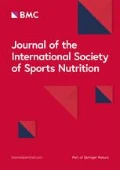Background
Current dietary intakes of active military personnel during intense training sessions may result in loss of lean tissue mass due to lower intake of energy and protein. It was hypothesized that a higher-protein diet (HPD) with frequent meals would result in greater lean tissue maintenance and improved performance during intense military training.
Design
36 Air Force cadets completed a 12-day training session. A HPD (40% carbohydrate, 30% protein, 30% fat) with frequent meals was prescribed to each participant. Cadets completed 4 hours of supervised exercise daily. Pre- and post-test assessments included: body weight, body composition, vertical jump height, leg power index (LPI) and anaerobic testing.
Results
A negative correlation was found between the change in average vertical jump height and protein intake. Total body mass increased by 0.6 ± 1.1 kg (p<.001), and percent body fat decreased by 1.1 ± 0.9 (p<.001). Fat-free mass increased by 1.3 ± 1.1 kg (p<.001), fat-mass decreased by 0.7 ± 0.7 (p<.001). Averaged 600 meter times decreased by 1.2 ± 1.8 seconds (p<.001). Peak LPI (LPI) and average LPI increased by 0.12 ± 0.22 (p<.001) and 0.13 ± 0.22 (p<.001), respectively. Total energy intake was 14,110 ± 4,389 kJ. Macronutrient breakdown of diets was 52 ± 11% carbohydrates (437 ± 155 g), 19 ± 4% protein (157 ± 65 g) and 32 ± 9% fat (119 ± 53 g). There was no correlation between meal frequency and anthropometric changes or performance changes. Meal frequency consisted of 64% of the subjects consuming 3 meals and 1 to 3 snacks daily, 22% of the subjects only consumed 2 meals and 1 to 3 snacks daily, and 13% of participants reported consuming 2 large meals and no snacks daily.
Conclusion
Frequent meals and snacking appears to have resulted in maintenance and an increase in fat-free mass. The increase in LPI may be partially due to the increase in FFM. However, due to lack of dietary adherence, the hypothesis of this study could not be tested accurately.
Acknowledgements
Thank you to Dave Durnil and James Lattimer for their assistance during data collection, and to Kristin Hodges for a critical reading of the manuscript.
Author information
Authors and Affiliations
Rights and permissions
Open Access This article is published under license to BioMed Central Ltd. This is an Open Access article is distributed under the terms of the Creative Commons Attribution 2.0 International License (https://creativecommons.org/licenses/by/2.0), which permits unrestricted use, distribution, and reproduction in any medium, provided the original work is properly cited.
About this article
Cite this article
Case, J.A., Haub, M.D., Teeter, A. et al. Use of higher-protein diets during intense military training to decrease lean tissue loss and improve performance. J Int Soc Sports Nutr 7 (Suppl 1), P5 (2010). https://doi.org/10.1186/1550-2783-7-S1-P5
Published:
DOI: https://doi.org/10.1186/1550-2783-7-S1-P5

